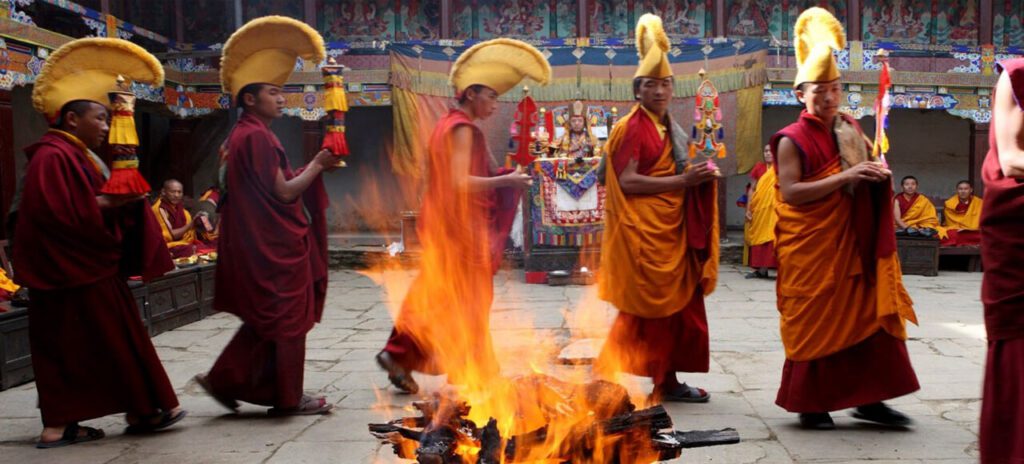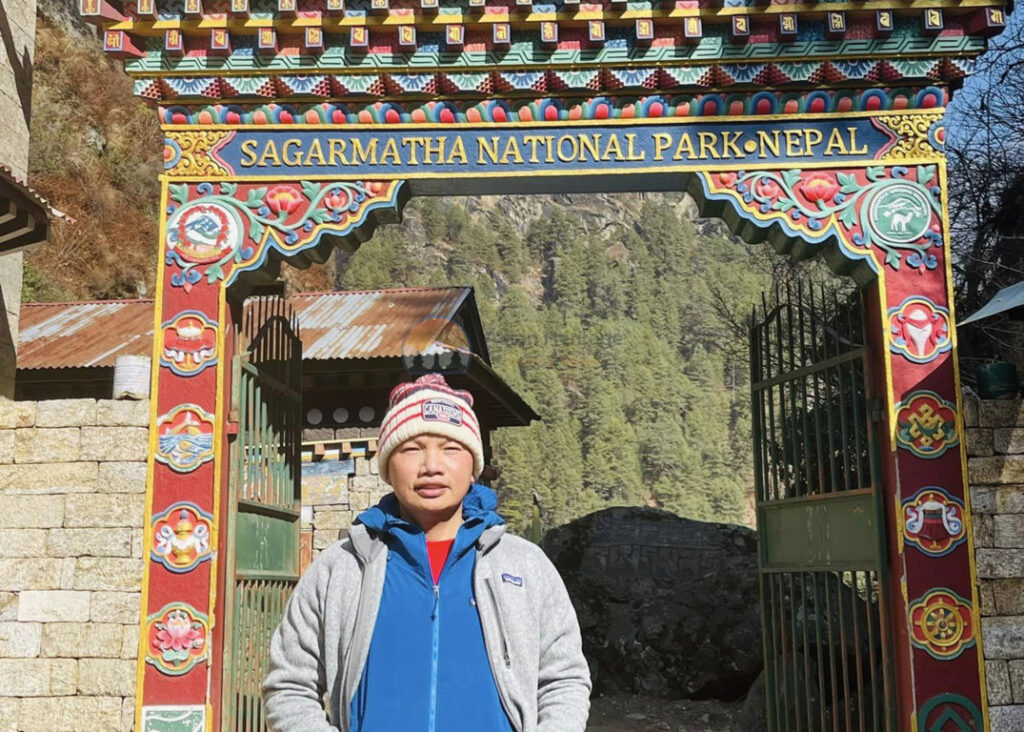The Mani Rimdu Festival is a fantastic celebration that brings together the Sherpa community and visitors from all over the world for a few days of fun, excitement, and cultural immersion. If you’re looking for a unique and unforgettable experience, this festival is definitely worth putting on your bucket list.
The Mani Rimdu Festival is a vibrant and colorful Buddhist celebration held in the breathtaking Himalayan region of Nepal. This festival is an extraordinary experience that combines religious traditions, culture, and a sense of community, making it a must-see event for all those interested in exploring the unique cultural heritage of Nepal.
The festival is also a perfect excuse to explore the stunning Khumbu region and its natural beauty. You can go on a trek to the Everest Base Camp, hike to the Gokyo Lakes, or simply take in the breathtaking views of the Himalayan Mountains.
Attending the Mani Rimdu Festival is a once-in-a-lifetime experience that will stay with you forever. The festival is not only an opportunity to witness the unique cultural heritage of Nepal, but it is also a chance to connect with the Sherpa community and experience their hospitality and warmth.
When and Where the Rimdu Festival is Celebrated?
Mani Rimdu is a Buddhist festival celebrated for 19 days to mark the founding of Buddhism by Guru Rinponchhe Padamasambha by the Sherpa community in the Everest region of Nepal. The festival usually takes place in the tenth lunar month of the Tibetan calendar, which typically falls between October and November in the Gregorian calendar.

The festival is held at three different monasteries in the Khumbu region: Tengboche, Thame, and Chiwong. Each monastery celebrates the festival on different dates, so it’s possible to attend all three ceremonies if you plan accordingly. However, Tengboche Monastery is the most famous and draws the largest number of visitors.
Why is it Celebrated?
The festival has a number of different meanings and purposes, depending on the monastery and the region in which it is celebrated. However, some of the common themes of the festival include:
- Celebrating the victory of Buddhism over local deities and the conversion of the Sherpa people to Buddhism.
- Seeking blessings for the well-being and prosperity of the local community, as well as for the world as a whole.
- Honoring the memory of the founder of Tibetan Buddhism, Guru Rinpoche, and his teachings on the path to enlightenment.
- Praying for peace and harmony in the world, and for the end of suffering for all beings.
Itinerary
Here are the steps to get to the festival from Kathmandu:
- Fly from Kathmandu to Lukla: The easiest way to get to the Everest region is to take a flight from Kathmandu to Lukla. This flight takes around 30 minutes and is operated by several airlines.
- Trek to Namche Bazaar: From Lukla, you will need to trek for two days to reach Namche Bazaar, the gateway to the Everest region. Namche Bazaar is the largest settlement in the area and has plenty of accommodation and food options.
- Trek to Tengboche: From Namche Bazaar, it’s another two-day trek to Tengboche, where the Mani Rimdu festival is held. Tengboche is home to the famous Tengboche Monastery, where the festival takes place.
- Attend the festival: The Mani Rimdu festival is usually held in November or December, and the dates vary each year based on the Tibetan lunar calendar. The festival is a three-day celebration, and you can witness traditional dances, mask performances, and other cultural activities.
Mani Rimdu Festival Celebration
The Mani Rimdu festival is a three-day celebration that takes place in the Tengboche Monastery, nestled in the Everest region of Nepal. It is an essential event in the Buddhist calendar and is celebrated in the tenth month of the Tibetan lunar calendar, usually falling in October or November. However, the preparations for this grand festival begin 19 days before the main event.

The monks of the Tengboche Monastery start preparing for the festival four days before the commencement. During this period, they construct a platform made from colored sand, known as the “mandala.” The platform serves as the focal point for the ceremony, and they also prepare sacred objects, such as statues of deities, masks, and costumes.
The first three days of the festival are dedicated to the “Drupchen” ceremony, where the monks engage in intense meditation and chanting. The monks recite the “Guru Rinpoche” prayer, which is believed to bring peace and prosperity to the region.
Last Three Days
The next three days are dedicated to the “Cham” dance, which is the highlight of the festival. The monks perform this dance in colorful costumes and masks, representing the victory of good over evil. The dance is accompanied by traditional music, including drums, cymbals, and horns.
During the next three days, the “Ngagpa Chenpo” ceremony takes place, which involves the empowerment of the monks. They receive blessings from the guru and deities, which is believed to enhance their spiritual power and ability to perform the rituals.
Also Read: Tengboche Monastery: The oldest monastery in Khumbu
The “Sand Mandala” ceremony takes place over the next three days, where the monks create a mandala from colored sand representing the universe. It is a beautiful piece of art and is later destroyed, symbolizing the impermanence of life.
The final three days of the festival involved the “Thongwa Chenpo” ceremony, which is the culmination of the entire festival. During this ceremony, the guru and deities bless the participants and the surrounding region. It is believed to bring peace, prosperity, and good fortune to the area.
Side Treks or Side Activities you can Participate
During the Rimdu festival, various side treks or activities are organized in and around the Tengboche monastery, which is the main venue for the festival. These activities include:
Mask dances:
Mask dances are an integral part of the Rimdu festival. These dances are performed by the monks of the Tengboche monastery and are meant to appease the local deities and ward off evil spirits. The dances are performed in the courtyard of the monastery and are accompanied by traditional music and chanting.
The dancers wear elaborate masks that represent various Buddhist deities and characters from Sherpa mythology. The masks are made from paper mache and are decorated with colorful paints and other ornaments. The dances are a visual spectacle and attract a large number of visitors from all over the world.
Fire Puja:
A fire puja is a traditional Hindu ritual that is performed to purify the environment and bring good luck. During the Rimdu festival, the monks of the Tengboche monastery perform a fire puja to appease the gods and goddesses.

The fire puja involves the offering of various items, such as grains, fruits, and flowers, to the fire. The smoke from the fire is believed to carry the prayers and wishes of the devotees to the heavens. The fire puja is a mesmerizing experience and attracts a large number of visitors.
Pilgrimage to the Tengboche Monastery:
The Tengboche monastery is a popular pilgrimage site for Buddhists from all over the world. During the Rimdu festival, many pilgrims visit the monastery to offer prayers and seek blessings from the monks. The monastery is located in a beautiful setting, surrounded by snow-capped mountains and pristine forests. The pilgrimage to the monastery is considered a spiritual journey and is an essential part of the Rimdu festival.
Trekking:
The Tengboche monastery is located in the Sagarmatha National Park, which is home to several trekking trails. Many visitors use the Rimdu festival as an opportunity to explore the beautiful landscapes of the Himalayan region and go trekking. The trekking trails in the region offer stunning views of the mountains, glaciers, and valleys.

Visitors can choose from a range of trekking options, from short day hikes to multi-day expeditions. Trekking during the Rimdu festival is a unique experience, as visitors can witness the festival celebrations and interact with the local Sherpa community.
Cultural programs:
In addition to the religious ceremonies, various cultural programs are also organized during the Rimdu festival. These programs include traditional Sherpa dances, music performances, and exhibitions of Sherpa handicrafts and artifacts. The cultural programs provide visitors with an opportunity to learn about the rich cultural heritage of the Sherpa community.
Visitors can witness traditional dances and music performances, sample local food and beverages, and shop for unique handicrafts and souvenirs. The cultural programs are a fun and engaging way to experience the Rimdu festival.
Let our expert team at Asian Heritage Treks and Travel take care of everything — from guided tours to personalized packing tips and travel arrangements.
Plan an unforgettable journey







